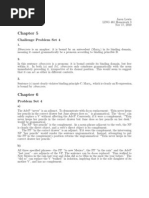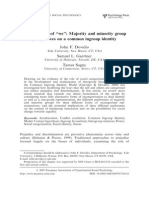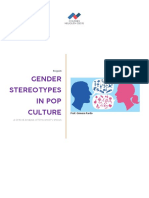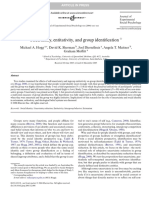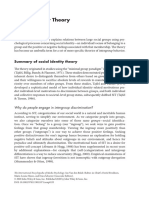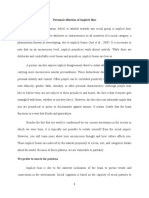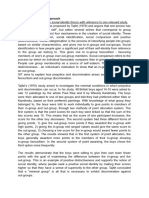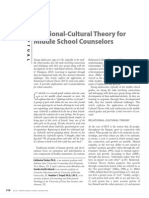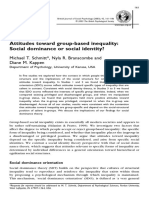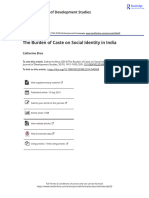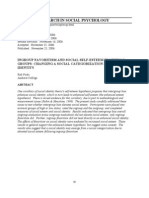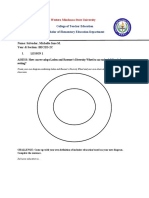Crisp13 4 PDF
Crisp13 4 PDF
Uploaded by
Cosmina MihaelaCopyright:
Available Formats
Crisp13 4 PDF
Crisp13 4 PDF
Uploaded by
Cosmina MihaelaOriginal Title
Copyright
Available Formats
Share this document
Did you find this document useful?
Is this content inappropriate?
Copyright:
Available Formats
Crisp13 4 PDF
Crisp13 4 PDF
Uploaded by
Cosmina MihaelaCopyright:
Available Formats
CURRENT RESEARCH IN SOCIAL PSYCHOLOGY
http://www.uiowa.edu/~grpproc/crisp/crisp.html Volume 13, No. 4 Submitted: August 29, 2007 First Revision: October 23, 2007 Accepted: October 28, 2007 Published: October 28, 2007
OUTGROUP FAVORITISM: THE ROLE OF POWER PERCEPTION, GENDER, AND CONSERVATISM
Luisa Batalha Uppsala University Nazar Akrami National University of Singapore Bo Ekehammar Uppsala University ABSTRACT Ingroup bias is a hallmark of intergroup relations. A growing body of research is now showing that outgroup bias is also a prevalent phenomenon, particularly among members of low-status groups. This research examines how perceptions of powerful outgroups are affected by their perceived legitimacy, and the ingroup members' gender, social dominance orientation, and conservatism. Based on a sample of 70 participants and a three-group experimental design (legitimate, illegitimate, no-explanation), the results showed that illegitimacy rather than legitimacy was associated with perceptions of power; that people attributed more positive traits when explanations for power were given than when they were not; that women perceived powerful groups as more powerful than men did; and that men, high social dominants and conservatives attributed less positive traits to a powerful group than women, low social dominants and liberals, respectively.
Current Research in Social Psychology (Vol. 13, No. 4)
(Batalha, et al.)
INTRODUCTION One of the most consistent findings on intergroup relations research is the ingroup bias effect, the tendency that members of a given social group have to favor their own group (Brewer & Brown, 1998; Hewstone, Rubin, & Willis, 2002). Interestingly, there is also an increasing body of evidence that people sometimes display outgroup favoritism (Boldry & Kashy, 1999; Jost & Banaji, 1994; Sidanius & Pratto, 1999). This happens particularly among members of low-status groups (Sachdev & Bourhis, 1991). Intergroup biases are dependent upon intergroup perceptions. Fiske and Neuberg (1990) developed a model of impression formation that distinguishes between more and less effortful processes of getting to know others. An impression of others is mostly formed through information conveyed in readily available categories such as gender, ethnicity, profession or religion. The model proposes a continuum of impression formation processes that runs from perception, based on categorization, to attribution of traits based on diagnostic information. Diagnostic-based impression formation necessitates personal contact with the person or group about whom the person is making an impression. On the other hand, all that category-based impression formation requires is an identifying label of the category in question. This means that if we are told that a person in question is black or a woman or a professor, it is enough to evoke impressions of that person solely based on preconceived ideas about people belonging to those social groups. This is the most immediate, automatic and stereotypical form of getting to know others and the least diagnostic and individuated form of knowledge about others. One key concept in Fiske and Neuberg's (1990) impression formation model is interdependence. Interdependence in their model is operationalized in terms of cooperation, in which an outcome is dependent on more than one partner. This outcome interdependence can be either symmetrical or asymmetrical. A symmetrical interdependence can be illustrated by a joint enterprise. An asymmetrical interdependence is exemplified by a relationship in which one partner has power over a subordinate's outcome. Outcome dependence motivates the perceiver to attend to more diagnostic information about the other on which he or she is in a relation of dependence. This requires personal contact. Individuation cannot otherwise occur. Problematically, people can find themselves in an interdependence relationship in which personal contact is non-existent. In such cases, individuation is strongly circumscribed and impression formation must be based on categorical information only. A situation in which the perceiver is in a position of dependency towards an anonymous entity puts him or her in a vulnerable predicament. Such a scenario can lead the perceiver to attribute benevolent characteristics to the powerful other or to categorize him or her in positive terms. In other words, asymmetrical outcome dependence may lead to outgroup favoritism by the members of a dependent group because it makes them feel better about their own situation (Jost & Banaji, 1994; Jost, Burgess, & Mosso, 2001). The way power holders are perceived is dependent on the degree of legitimacy of their power position (Zeldtich, 2001). There is evidence that powerful groups, more often than powerless groups, are evaluated positively, are perceived as more competent and are less often the target of negative stereotypes (see Brauer & Bourhis, 2006). Jost, Banaji and Nosek (2004) explain this in terms of system justification. That is, people are motivated to legitimize existing social arrangements, and they do so by ascribing positive attributes to members of high-power groups. For example, Haines and Jost (2000) showed that there is a relationship between the perception
39
Current Research in Social Psychology (Vol. 13, No. 4)
(Batalha, et al.)
of legitimate/illegitimate power positions and trait attribution. By manipulating power differentials, where the participants lacked power in relation to bogus outgroups, they showed that participants exaggerated the extent to which power differences were legitimate. Participants also attributed positive trait perceptions to the outgroup even when there were no explanations as to why the outgroup was in power. Haines and Jost (2000) analyzed the effects of power differences and of explanations for the power differentials on stereotypical perceptions. They did not, however, analyze whether there were differences in these perceptions between levels of legitimacy (i.e., legitimate power, illegitimate power, no explanation for the power position) or whether there was a linear increase of power perception as a function of legitimacy. We aimed to examine whether people who are in a dependent and vulnerable position in relation to a powerful outgroup attribute positive traits differently depending on the degree of legitimacy of the powerful group's power position. We also examined whether there is a monotonic increase in perceptions of power, depending on the degree of legitimacy. We hypothesized that people will perceive a legitimate power group as being the most powerful (H1), and attribute to them the most positive traits (H2), followed by an illegitimate power group and, finally, a group whose power position is not explained. Gender and Outgroup Perception Social status affects intergroup perception (Hinkle & Brown, 1990). Likewise, the relative power of a group affects both how its members are perceived and in turn perceive others (Brauer & Bourhis, 2006). As a social category, women have less power and a lower social status than men (Goodwin & Fiske, 2001). Research shows that gender impacts on perceptions of outgroup homogeneity and social status (Lorenzi-Cioldi, 1993). If both dependence and low social status induces perceivers to display outgroup favoritism, then it is reasonable to assume that women who find themselves in positions of dependence would display more outgroup favoritism than men. We hypothesized that this would occur for the reason that women's lower status as a gender would put them in a double subordinate position compared to men. We hypothesized (H3) therefore that women, compared to men, will perceive relatively powerful outgroups to be more powerful. We also asked whether the differences in social status between the genders would influence men and women to perceive powerful outgroup members' traits differently. Thus, the fourth hypothesis (H4) that we tested was that when there is a power differential between an outgroup and the ingroup favoring the outgroup, women will attribute more positive attributes to members of the outgroup than men will. Conservatism, and Outgroup Perception Group membership, in itself, can hold the possibility of guaranteeing power, or the lack thereof to its members (Tajfel & Turner, 1979). As membership of some low-status groups is often not chosen, but given, and social mobility is impossible or strongly circumscribed, low-status groups have a vested interest in rationalizing social hierarchies. However, this rationalization seems to be related to individual differences in social dominance orientation (SDO; Pratto, Sidanius, Stallworth, & Malle, 1994) and political conservatism (Jost, Banaji, & Nosek, 2004). That is, responses to ingroup inferiority are dependent on SDO level and political orientation. These two variables are also positively correlated (Sidanius & Pratto, 1999). SDO is regarded as a conservative ideology and refers to "a general desire for unequal relations among social groups,
40
Current Research in Social Psychology (Vol. 13, No. 4)
(Batalha, et al.)
regardless of whether this means ingroup domination or ingroup subordination" (Sidanius, Levin, Federico, & Pratto, 2001, p. 312). In other words, high social dominants believe that society is, by necessity, stratified and members at the top of the stratification, as well as those at the bottom, deserve their dominant or subordinate social positions. There is evidence both for (Sidanius & Pratto, 1999; Carter, Hall, Carney, & Rosip, 2006) and against (Dambrun, Guimond, & Duarte, 2002) an association between SDO and legitimizing myths such as stereotypes, which are normally shared (negative) beliefs that are associated with an established social category. Positive stereotypes would probably show an inverse pattern. In any social encounter, people make judgments of others. If the other does not belong to a wellknown social category, people form an opinion in situ that is based on the available category information. In a situation where people are dependent on an outgroup of which they have no prior knowledge we examined whether conservative ideologies would induce people to perceive the powerful outgroup in less positive terms. Our fifth hypothesis (H5) was, therefore, that SDO is negatively associated with the attribution of positive traits to members of a relatively more powerful outgroup. Finally, we also hypothesized (H6) that political orientation in the form of political conservatism is negatively associated with the attribution of positive traits to a powerful outgroup. Overview With a few exceptions, we followed Haines and Jost's (2000) methodological approach to create power differentials between groups. More specifically, participants learned that there was a group (experimental conditions with three different degrees of legitimacy) that would be judging their performance in two tasks. By so doing, power differentials were created between the ostensible judging groups and the participants, where the bogus group held a higher power position compared to participants. The study was also designed to induce a feeling of group membership and group identification among the participants. The participants in the experimental conditions were led to believe that they were going to perform two tasks (ostensible study purpose) that would be judged by the outgroup. In one condition, a legitimate reason was given for the position of power held by the outgroup. In another, the reason given was illegitimate, and in the third condition no explanation was given for the outgroup's power position. METHOD Participants Participants were recruited through lists posted on boards in several university departments, at the university's library and at the local job centre. Participants were asked to volunteer for a psychological experiment and to leave their name and phone number. There were a total of 70 participants (30 men and 40 women). Their age ranged from 19 to 57 years (M = 24.9 years; SD = 5.9 years) and they received cinema vouchers as a reward for their participation. Independent Measures
41
Current Research in Social Psychology (Vol. 13, No. 4)
(Batalha, et al.)
The independent experimental variables were power and legitimacy, and the nonexperimental were participant gender, political orientation, and SDO. Political orientation was measured by a visual analog scale, a 10 centimeter line with left and right as anchors. Participants were asked to mark on the line where they stood politically. The participants' SDO was measured by a Swedish translation (cf. Akrami, Ekehammar, & Araya, 2000) of Pratto et al. 's (1994) SDO-6 scale. The scale is composed of 16 items and the answers are indicated on a scale ranging from 1 (Do not agree at all) to 5 (Agree fully). Examples of items are: Some groups of people are just inferior to others; We would have fewer problems if we treated all groups equally. The unweighted sum of the item scores constitutes the respondent's SDO score. In the present study, the Cronbach alpha reliability of SDO was shown to be .86, which is satisfactory. The SDO scale was used in its continuous form in order not to decrease variance and power (see Cohen, 1983; MacCollum, Zhang, Preacher, & Rucker, 2002). Dependent Measures The dependent variables were perception of power and trait perception. Perception of power was measured through a single item: How much control do you feel that the other group has over your group's performance at the moment? The responses were given on a 10-point Likert scale ranging from 0 (No control) to 9 (Complete control). Outgroup trait perception was measured with items rating the participants' perception of the outgroup as intelligent and responsible (see Haines & Jost, 2000). For intelligent the question read: How intelligent do you think that the other group is? For responsible the question was: How responsible do you think that the other group is? Responses were measured on a 10-point Likert scale ranging from 0 (Not at all) to 9 (Very much). A single item was introduced to control whether the legitimate and illegitimate groups were perceived as having different degrees of legitimacy. It read: How much do you think that the other group has the right to judge your group's performance on the suicide tasks?. Responses were measured on a 10-point Likert scale, ranging from 0 (Not at all) to 9 (Very much). Procedure Participants were contacted by the project leader who informed them that the study would be about suicide (ostensible purpose). Here participants were given the opportunity to decline participation in the study. All but two individuals agreed to participate. They were then quasirandomly assigned into the four different groups. Attempts were made to obtain an equal gender distribution within all four groups. The number of participants in the experimental sessions ranged from 3 to 7 (M = 5.2; SD = 1.1). In total, 14 experimental sessions were conducted by a male experimenter blind to the aim of the study. On arrival, participants in all conditions were told that the aim of the study was to examine factors that might predict suicide and could therefore help in future preventive work. At this stage they were again offered the opportunity to decline participation. None of the attendants left the session. In the next phase they were asked to choose a group name. This was done in order to evoke a feeling of group membership. Once they agreed upon a group name they wrote it on tags that they attached to their clothes. They were then informed that they were about to perform two
42
Current Research in Social Psychology (Vol. 13, No. 4)
(Batalha, et al.)
tasks related to suicide. In the first task they received a list with pairs of suicide notes (these notes were taken from the Internet and had been written by famous people that had committed suicide) and were instructed to decide which note in the pair was true and which was false. In order to make the task more meaningful, they were also asked to justify their choice. The second task consisted of writing down 5 symptoms that they believed are displayed by suicidal people. After that they were told that they would be filling out a few questionnaires. Next, participants were informed that in a room upstairs there was another group (which did not in reality exist) that would be judging their performance on the suicide tasks. If this group decided that their group performed well on both tasks they would receive an extra cinema voucher in addition to the one they were promised from the outset. On the other hand, if the judging group decided that they did not perform well enough they would not receive any extra cinema voucher. Participants in the legitimate condition were told that the judging group consisted of final year students from the psychology program at the university who worked with suicide prevention research and practiced at a suicide prevention unit. Participants in the illegitimate condition were told that the judging group was chosen in the same way as themselves and that their allocation to the judging group was chosen at random. Participants in the no-explanation condition were simply told that there was a group of people who would be judging their performance on the suicide tasks. After learning about the "existence" of the judging outgroup, participants were asked to perform the task with the suicide notes and symptoms. Participants were told that they should arrive at a consensual and democratic decision. They had 20 minutes for the first task and 10 minutes for the second. They were also asked to write down the group's name on the assessment paper they handed in for judgment. Following this instruction, the experiment leader left the room with their assessment for the bogus group to judge. In the meantime, participants were asked to complete questionnaires assessing demographic variables, and political orientation, perceived characteristics of the judging group and the judging group's power and legitimacy. The experimenter came back and gave them the SDO questionnaire to complete. They were told that this questionnaire could contain relevant information about how people reason about suicide. We chose to give the SDO scale after the manipulation because its administration prior to it could prime participants in ways we could not control. In support for this procedure there is recent research showing a strong association between basic personality and SDO (e.g., Akrami & Ekehammar, 2006). This suggests that this variable should not change significantly under different conditions. After some time, the experimenter went out again ostensibly to get the judgment from the bogus group about their performance. When he came back he told them that they had performed well and could go. Before they left they were asked to leave their e-mail or telephone number in order to receive more information about the study at a later date. This was not compulsory. After all the experimental sessions were completed the participants were debriefed by e-mail and were then told what the real aim of the study was. An opportunity was given for further contact with the project leader.
43
Current Research in Social Psychology (Vol. 13, No. 4)
(Batalha, et al.)
RESULTS Manipulation Check The legitimacy manipulation was checked through a one-tailed t-test with condition (legitimate and illegitimate) as independent variable and legitimacy as the dependent variable. As expected, the results, t(47) = 1.69, p < .05, eta-square = .12, showed that the group that received a legitimate explanation (M = 6.55, SD = 1.65, n = 22) perceived the outgroup as having more legitimacy (right to judge the ingroup) than the group that received an illegitimate explanation (M = 5.44, SD = 2.67, n = 27). The legitimacy manipulation was therefore successful. Power, Legitimacy, and Outgroup Perception To examine H1, whether people perceived groups that differed in degrees of legitimacy also differed in power, we conducted a one-way ANOVA. The results showed a significant difference between the groups, F(2, 66) = 4.71, p < .02, eta-square = .13 (see means in Table 1). The follow-up post-hoc test with the Bonferroni adjustment (p < .01) showed a significant difference between the legitimate and illegitimate groups but not between these two groups and the group that received no explanation (legitimate, p = .57; illegitimate, p = .31). Contrary to expectations the legitimate group was perceived as having least power, whereas the illegitimate group was perceived as the most powerful. Table 1. Perception of Power as a Function of Experimental Condition Group M SD n Legitimate 4.29 2.61 21 Illegitimate 6.67 2.06 27 No explanation 5.38 3.38 21 A MANOVA was performed in order to test H2, that the perception of the outgroup as more intelligent and responsible would be stronger for the participants in the legitimate group followed by the illegitimate and no-explanation group. The multivariate effect of group, F(4, 130) = 3.37, p < .02, Wilks's lambda = .82, eta-square = .09, was accompanied by a significant univariate effect on the trait intelligent, F(2, 66) = 4.19, p < .02, eta-square = .12, and responsible, F(2, 66) = 3.38, p < .05, eta-square = .09 (see means in Table 2). A one-tailed Dunnett follow-up test (the no-explanation group is used as a control, see Howell, 1992) showed that for the trait intelligent there was a significant difference between the no-explanation group and the group that received a legitimate explanation (p < .03), and the group that received an illegitimate explanation (p < .02). For responsible, the Dunnett test showed that the no-explanation group differed significantly from the legitimate group (p < .03), but not from the illegitimate group (p = .71). Table 2. Trait Perception as a Function of Experimental Condition Intelligent Responsible Group M SD M SD Legitimate (n = 21) 6.62 0.86 7.14 1.01 Illegitimate (n = 27) 6.63 1.12 6.30 1.56 No explanation (n = 21) 5.71 1.55 6.00 1.76
44
Current Research in Social Psychology (Vol. 13, No. 4)
(Batalha, et al.)
Gender, Power and Outgroup Perception Hypothesis 3 proposed that women would perceive the members of the judging group as more powerful than men. The hypothesis was tested with a one-tailed t-test (see, Howell, 1992). This hypothesis was supported, t(67) = 1.75, eta-square = .04, p < .04, as the means displayed in Table 3 show that women perceived the judging outgroup as more powerful than did men. Table 3. Power and Trait Perception as a Function of Gender Female (n = 49) Male (n = 28) Variable M SD M SD Power perception 6.05 2.75 4.86 2.84 Intelligent 6.68 1.07 5.90 1.37 Responsible 6.48 1.63 6.45 1.43 Hypothesis 4, proposing that women would attribute more positive traits than men, was tested with a MANOVA. This analysis showed a multivariate effect of gender, F(2, 66) = 4.84, p < .01, Wilks's lambda = .87, eta-square = .13. The univariate tests showed a significant difference for the trait intelligent F(1, 67) = 7.00, p < .01, eta-square = .10, but not for the trait responsible, F(1, 67) = 0.01, p = .94, eta-square = .00 (for means see Table 3). The results, therefore, only partially supported the hypothesis. Social Dominance, Political Orientation, and Outgroup Perception Pearson correlation analyses were performed to test whether SDO was associated with trait perception. The results showed a negative correlation of SDO with the trait intelligent (r = -.27, p < .03, n = 69). The correlation of SDO with the trait responsible (r = -.10, p = .40, n = 69) was also negative, but not significant. Pearson correlation analyses were also performed to test whether there was a relationship between political orientation and the attribution of positive traits to the outgroup. Similarly to the results obtained for SDO, the analysis showed a negative correlation (r = -.33, p < .01, n = 68) between political orientation and the perception of members of the outgroup as intelligent. That is, the more conservative participants were, the less they experienced the outgroup as intelligent. For the trait responsible, the correlation was also negative, but not significant (r = -.14, p = .24, n = 68). DISCUSSION Contrary to expectations, the participants perceived the outgroup with illegitimate power as more powerful than the group with legitimate power. This can be interpreted as strong support for a system justification explanation to the perception of social reality (Jost & Banaji, 1994). That is, the participants may have found it more necessary to exaggerate a power differential between themselves and an illegitimate authority than a legitimate one in order to feel better about their unjust subordination. In other words, they may have compensated for the threat that illegitimate power entails. This interpretation fits well with the assertion that people are motivated to justify
45
Current Research in Social Psychology (Vol. 13, No. 4)
(Batalha, et al.)
and rationalize the status quo, even if this justification is detrimental to their welfare (Jost & Banaji, 1994). In fact, this suggests an even more blatant form of system justification than the perception of the outgroup as more powerful when it holds legitimate power. Moreover, the results also show that women, who were in a doubly vulnerable position compared to men, perceived the relatively powerful group as more powerful than did men. This also supports a system justification interpretation in that women's lower social status may have predisposed them to display outgroup favoritism. Albeit providing indications for outgroup favoritism a follow-up study in which ingroup favoritism also is measured, is necessary to substantiate this interpretation. The trait intelligent was more consistent across our analyses than was the trait responsible. Perceived intelligence was found to be dependent on whether the outgroup's power position was explained or not, but it was not found to be a function of legitimacy. Perceived intelligence was also found to be dependent on gender. Women perceived the outgroup as more intelligent than men did. Moreover, the perception of people as intelligent was negatively related to both SDO, and political conservatism. Perceived responsibility, on the other hand, was found to be dependent on the degree of legitimacy. Gender, SDO, and political conservatism had no significant effects on the perception of this trait. One reason for the lack of differences between groups and genders and the lack of correlations for the trait responsible could be that the outgroup was presented as being in charge. That is, the outgroup had responsibility over the ingroup's outcome. A fact that legitimacy/illegitimacy or the ideological views of the participants would not change. The perception of others as intelligent on the other hand, may be more susceptible to external influences such as explanation, gender or conservative views. Members of the outgroup were not necessarily perceived as intelligent. However, because they were in power and had control over the ingroup's outcome, it may be that the participants were more inclined to categorize the outgroup as intelligent. In a similar vein, women, who are in a more vulnerable position than men because of their gender membership (Lorenzo-Cioldi, 1993), may also have been more inclined to display outgroup favoritism than men. The group and gender analyses regarding the perception of power and traits showed relatively low effect sizes, which ranged from .04 to .13. This means that only a relatively low amount of variance was explained. This is probably due to the manipulation, which may have been too weak. The no-explanation condition may have been perceived as too similar to the illegitimate condition. A follow up study making use of a stronger manipulation would probably yield stronger effect sizes and thus provide results that are more robust. As predicted, conservative views in the form of SDO and political conservatism correlated negatively with the trait intelligent. That is, the more social dominant and conservative people were, the less they perceived the outgroup as intelligent. This is in line with social dominance theory (Sidanius & Pratto, 1999) in that social dominants and conservatives display comparatively less outgroup favoritism. Impression formation research is conducted mostly with reference to symmetrical or asymmetrical interdependence, and it has generally required some kind of personal contact so
46
Current Research in Social Psychology (Vol. 13, No. 4)
(Batalha, et al.)
that individuation is possible (Fiske & Neuberg, 1990). However, in life, situations in which the possibility of individuation is strongly circumscribed are not unusual. In this investigation we examined interdependence between groups rather than between individuals. Moreover, in our study, interdependence was characterized by a high degree of anonymity. Job recruiting situations, where the applicant does not know who will be judging his or her merits, is an example where both asymmetrical dependence and anonymity occur. In the present study we showed that despite the asymmetry and anonymity participants still make positive attributions to a relatively powerful outgroup. Our results indicate that social dominants and political conservatives do this to a lesser degree. This raises the issues of whether these groups react to dependency situations differently from low dominants and liberals respectively, and if so, what psychological mechanisms are at play? REFERENCES Akrami, N., & Ekehammar, B. (2006). Right-wing authoritarianism and social dominance orientation: Their roots in big five personality factors and facets. Journal of Individual Differences, 27, 117-126. Akrami, N., Ekehammar, B., & Araya, T. (2000). Classical and modern racial prejudice: A study of attitudes toward immigrants in Sweden. European Journal of Social Psychology, 30, 521-532. Brauer, M., & Bourhis, R. Y. (2006). Social power. European Journal of Social Psychology, 36, 601-616. Boldry, J. G., & Kashy, D. A. (1999). Intergroup perception in naturally occurring groups of differential status: A social relations perspective. Journal of Personality and Social Psychology, 77, 1200-1212. Brewer, M. B., & Brown, R. (1998). Intergroup relations. In D. T., Gilbert, S. T. Fiske, & G. Lindzey (Eds.), The handbook of social psychology (Vol. 2, pp. 554-594). Boston: McGraw-Hill. Carter, J. D., Hall, J. A., Carney, D. R., & Rosip, J. C. (2006). Individual differences in the acceptance of stereotyping. Journal of Research in Personality, 40, 1103-1118. Cohen, J. (1983). The cost of dichotomization. Applied Psychological Measurement, 7, 249-253. Dambrun, M., Guimond. S., & Duarte. S. (2002). The impact of hierarchy-enhancing vs. attenuating academic major on stereotyping: The mediating role of perceived social norm. Current Research in Social Psychology, 7, 114-136. Fiske, S. T., & Neuberg, S. L. (1990). A continuum model of impression formation, from category-based to individuating processes: Influence of information and motivation on attention and interpretation. In M. P. Zanna (Ed.), Advances in experimental social psychology (Vol. 23, pp. 1-74). New York: Academic Press.
47
Current Research in Social Psychology (Vol. 13, No. 4)
(Batalha, et al.)
Goodwin, A., & Fiske, S. T. (2001). Power and gender: The double-edged sword of ambivalence. In R. K. Unger (Ed.), Handbook of the psychology of women and gender. New York: Wiley. Haines, E. L., & Jost, J. T. (2000). Placating the powerless: Effects of legitimate and illegitimate explanation on affect, memory, and stereotyping. Social Justice Research, 13, 219-236. Hewstone, M., Rubin, M., & Willis, H. (2002). Intergroup bias. Annual Review of Psychology, 53, 575-604. Hinkle, S., & Brown, R. (1990). Intergroup Comparisons and social identity: Some links and lacunae. In D. Abrams, & M. A. Hogg (Eds.), Social identity theory: Constructive and critical advances (pp. 48-70). New York: Springer. Howell, D. C. (1992). Statistical methods for psychology (3rd ed.). Belmont, CA: Duxbury. Jost, J. T., & Banaji, M. R. (1994). The role of stereotyping in system-justification and the production of false consciousness. British Journal of Social Psychology, 33, 1-27. Jost, J. T., Banaji, M. R., & Nosek, B. A. (2004). A decade of system justification theory: Accumulated evidence of conscious and unconscious bolstering of the status quo. Political Psychology, 25, 881-919. Jost, J. T., Burgess, D., & Mosso, C. O. (2001). Conflicts of legitimation among self, group, and system: The integrative potential of system justification theory. In J. T. Jost & B. Major (Eds.), The psychology of legitimacy: Emerging perspectives on ideology, justice, and intergroup relations (pp. 363-388). Cambridge, UK: University Press. Lorenzi-Cioldi, F. (1993). They all look alike, but so do wesometimes: Perceptions of ingroup and out-group homogeneity as a function of sex and context. British Journal of Social Psychology, 32, 111-124. MacCallum, R. C., Zhang, S., Preacher, K. J., & Rucker, D. D. (2002). On the practice of dichotomization of quantitative variables. Psychological Methods, 7, 19-40. Pratto, F., Sidanius, J., Stallworth, L. M., & Malle, B. (1994). Social dominance orientation: A personality variable predicting social and political attitudes. Journal of Personality and Social Psychology, 67, 741-763. Sachdev, I., & Bourhis, R. Y. (1991). Power and status differentials in minority and majority group relations. European Journal of Social Psychology, 21, 1-24. Sidanius, J., Levin, S., Federico. C., & Pratto, F. (2001). Legitimizing ideologies: The social dominance approach. In J. T. Jost & B. Major (Eds.), The psychology of legitimacy: Emerging perspectives on ideology, justice, and intergroup relations (pp. 307-331). Cambridge, UK: University Press.
48
Current Research in Social Psychology (Vol. 13, No. 4)
(Batalha, et al.)
Sidanius, J., & Pratto, F. (1999). Social dominance: An intergroup theory of social hierarchy and oppression. Cambridge, UK: University Press. Tajfel, H., & Turner, J. (1979). An integrative theory of intergroup conflict. In W. G. Austin, & S. Worchel (Eds.), The psychology of intergroup relations. Monterey, CA: Brook/Cole. Zelditch, M. (2001). Processes of legitimation: Recent developments and new directions. Social Psychology Quarterly, 64, 4-17. APPENDIX B: DESCRIPTIVE STATISTICS AND CORRELATIONS AMONG THE DEPENDENT VARIABLES Intelligent Responsible Power perception Responsible .53** Power perception .37** -.01 M 6.35 6.46 5.55 SD 1.26 1.54 2.83 *p < .05, **p < .01. N = 69 for all variables AUTHOR NOTE The authors would like to thank Magnus Gylje for his assistance with data collection and Brian Jones for comments on the English. This research was partially supported by the Swedish Research Council; contract number: 421-2005-1965. Correspondence should be sent to Luisa Batalha, luisa.batalha-hallmen@psyk.uu.se AUTHOR BIOGRAPHIES Luisa Batalha is a PhD student at the Department of Psychology, Uppsala University. Her e-mail address is luisa.batalha-hallmen@psyk.uu.se Nazar Akrami is a Visiting Fellow at the Department of Psychology, National University of Singapore. His e-mail address is psyan@nus.edu.sg Bo Ekehammar is Professor of psychology at the Department of Psychology, Uppsala University. His e-mail address is bo.ekehammar@psyk.uu.se
49
You might also like
- Ling 461 HW 3Document4 pagesLing 461 HW 3dukexcNo ratings yet
- Social Dominance Orientation, Right-Wing Authoritarianism, and Their Relation With Alienation and Spheres of ControlDocument9 pagesSocial Dominance Orientation, Right-Wing Authoritarianism, and Their Relation With Alienation and Spheres of ControlNedima DzaferagicNo ratings yet
- Psyc 4p71 Essay - IntersectionalityDocument8 pagesPsyc 4p71 Essay - Intersectionalityapi-534748698No ratings yet
- Semiologie Medicala (George Ioan Pandele) Vol 1 - 2001Document260 pagesSemiologie Medicala (George Ioan Pandele) Vol 1 - 2001med_dana100% (4)
- 22 GettingToKnowYouDocument29 pages22 GettingToKnowYouCadjosse LtaNo ratings yet
- Sensoy and Diangelo 4 and 5Document2 pagesSensoy and Diangelo 4 and 5api-709290948No ratings yet
- StereotypesDocument5 pagesStereotypesSanam RajNo ratings yet
- Formation: SchemaDocument8 pagesFormation: SchemaGreen LightNo ratings yet
- Colour Protest in Post-War Georgia - Chronology of Rose RevolutionDocument22 pagesColour Protest in Post-War Georgia - Chronology of Rose RevolutionMachurishviliNinoNo ratings yet
- Karakashian PDFDocument21 pagesKarakashian PDFOktha Ardiansyah JailzzNo ratings yet
- (Sarah Radcliffe) Remaking The Nation Place, IdenDocument10 pages(Sarah Radcliffe) Remaking The Nation Place, IdentorbenalbertsenNo ratings yet
- Stereotyping and Society A Barrier To Achieving SoDocument11 pagesStereotyping and Society A Barrier To Achieving SoRamiz OruceliyevNo ratings yet
- Black Sheep Effect and The Identification With GroupDocument21 pagesBlack Sheep Effect and The Identification With GroupState of MindNo ratings yet
- RetrieveDocument19 pagesRetrievestubbNo ratings yet
- The Social Psychology of Discrimination: Theory, Measurement and ConsequencesDocument29 pagesThe Social Psychology of Discrimination: Theory, Measurement and ConsequencesRohit Vijay PatilNo ratings yet
- The Object of Desire: How Being Objectified Creates Sexual Pressure For Women in Heterosexual RelationshipsDocument52 pagesThe Object of Desire: How Being Objectified Creates Sexual Pressure For Women in Heterosexual RelationshipsHiuyvNo ratings yet
- Another Wiew of WEDocument35 pagesAnother Wiew of WEHoa NguyenNo ratings yet
- DP Psychology - StereotypingDocument3 pagesDP Psychology - StereotypingPalaash DubeyNo ratings yet
- 5 KaiseretalDocument17 pages5 KaiseretalJuan José MogatNo ratings yet
- Project - Gender Stereotypes in Pop CultureDocument20 pagesProject - Gender Stereotypes in Pop CultureEla GomezNo ratings yet
- Social Dominance Orientation (Pratto, Sidanius)Document24 pagesSocial Dominance Orientation (Pratto, Sidanius)Raihan Nurul HadiNo ratings yet
- Gender FinalDocument10 pagesGender FinalKalyani SarangiNo ratings yet
- Mental Illness Senior Project Final PaperDocument24 pagesMental Illness Senior Project Final Papercassondrazaleski100% (1)
- Hogg 2006Document8 pagesHogg 2006khalid alharbiNo ratings yet
- Group Dynamics and Social PsychologyDocument11 pagesGroup Dynamics and Social PsychologyjgomezNo ratings yet
- Social Identity TheoryDocument7 pagesSocial Identity Theorypsic.tatianebezerraNo ratings yet
- Eisenchlas (2012) - Gender Roles and Expectations: Any Changes Online?Document11 pagesEisenchlas (2012) - Gender Roles and Expectations: Any Changes Online?RB.ARGNo ratings yet
- Examining Dispositional and SituationalDocument22 pagesExamining Dispositional and Situational6k032th8eNo ratings yet
- RDocument3 pagesRhhey7429No ratings yet
- Study on Gamma Bias Paul ConnorDocument64 pagesStudy on Gamma Bias Paul ConnorJCaNo ratings yet
- White Knighting: How Help Reinforces Gender Differences Between Men and WomenDocument19 pagesWhite Knighting: How Help Reinforces Gender Differences Between Men and WomenĐan TâmNo ratings yet
- Socio Enotes4HigherEducationDocument6 pagesSocio Enotes4HigherEducationDr. Pragyan SinghNo ratings yet
- Reflection On Implicit BiasnessDocument3 pagesReflection On Implicit BiasnessSehrish100% (3)
- PSYCHOLOGY Social InfluencesDocument6 pagesPSYCHOLOGY Social Influencesmnkanyi24No ratings yet
- IB Psychology Sociocultural Approach SAQsDocument7 pagesIB Psychology Sociocultural Approach SAQscastellieleonora00No ratings yet
- Chartrand NC ReactanceDocument8 pagesChartrand NC ReactanceBatuhan PehlivanlıNo ratings yet
- Stigma, Prejudice, Discrimination and HealthDocument16 pagesStigma, Prejudice, Discrimination and Healthnicoleta5aldea100% (1)
- Swann Identity FusionDocument15 pagesSwann Identity Fusionspames23 spames23No ratings yet
- Review of Related Literature: Gender StereotypesDocument34 pagesReview of Related Literature: Gender Stereotypesalphashane Flores100% (1)
- Final CheckedDocument6 pagesFinal CheckednoemieedwardsNo ratings yet
- Adizas Research PaperDocument17 pagesAdizas Research Paperapi-672111550No ratings yet
- Hudson & Busseri (2012) Baja Capacidad Cognitiva Prevé Mayor Prejuicio Entre Las Personas Con Ideología Derechista y Bajo Contacto IntergrupalDocument9 pagesHudson & Busseri (2012) Baja Capacidad Cognitiva Prevé Mayor Prejuicio Entre Las Personas Con Ideología Derechista y Bajo Contacto IntergrupalTito Aedo SaraviaNo ratings yet
- 3 s2.0 B0080430767039991 MainDocument5 pages3 s2.0 B0080430767039991 MainALINA DONIGA .No ratings yet
- Locus of Control and The Attribution ForDocument20 pagesLocus of Control and The Attribution ForAdriana RojasNo ratings yet
- Relational-Cultural Theory For Middle School CounselorsDocument8 pagesRelational-Cultural Theory For Middle School CounselorspipitingesNo ratings yet
- Article Review On Gender and Social InflDocument3 pagesArticle Review On Gender and Social InflMahedre ZenebeNo ratings yet
- Attitudes Toward Group-Based Inequality Social Dominance or Social Identity Schmitt Branscombe KappenDocument26 pagesAttitudes Toward Group-Based Inequality Social Dominance or Social Identity Schmitt Branscombe KappenTom Waspe TeachNo ratings yet
- Name: Kunika Malhotra Roll No. 20201022Document20 pagesName: Kunika Malhotra Roll No. 20201022adiba KhanNo ratings yet
- Social Psychological and Personality Science Volume Issue 2016 (Doi 10.1177/1948550616660592) Brandt, M. J. Crawford, J. T. - Answering Unresolved Questions About The Relationship Between CognitivDocument9 pagesSocial Psychological and Personality Science Volume Issue 2016 (Doi 10.1177/1948550616660592) Brandt, M. J. Crawford, J. T. - Answering Unresolved Questions About The Relationship Between Cognitivpoli275No ratings yet
- SociologyDocument23 pagesSociologywaqarkhankhambaNo ratings yet
- Does Community Belongingness 060318Document14 pagesDoes Community Belongingness 060318denverclardmNo ratings yet
- LoveDocument14 pagesLoveNandha KumarNo ratings yet
- Sex Differences in Conformity Status andDocument18 pagesSex Differences in Conformity Status andChelsea WongNo ratings yet
- Thesis Chapter 3 AnsaDocument2 pagesThesis Chapter 3 AnsaSamia YousafNo ratings yet
- Unit-1 GENDER SENSITISATIONDocument7 pagesUnit-1 GENDER SENSITISATIONPiyushNo ratings yet
- Carney - Beliefs About The Nonverbal Expression of Social PowerDocument19 pagesCarney - Beliefs About The Nonverbal Expression of Social PowerMiltonNo ratings yet
- Gender RolesDocument12 pagesGender RolesYULIZA GARRO MENDEZNo ratings yet
- Stereotype, Prejudice and DiscriminationDocument5 pagesStereotype, Prejudice and Discriminationdammyakapo01No ratings yet
- The Burden of Caste On Social Identity in IndiaDocument20 pagesThe Burden of Caste On Social Identity in IndiaRydel RatliffNo ratings yet
- Flynn Having An Open MindDocument11 pagesFlynn Having An Open MindJoelNo ratings yet
- He As OnDocument18 pagesHe As OniolandaszaboNo ratings yet
- Strategic Positioning: The Litigant and the Mandated ClientFrom EverandStrategic Positioning: The Litigant and the Mandated ClientRating: 5 out of 5 stars5/5 (1)
- Crisp14 5Document12 pagesCrisp14 5Cosmina MihaelaNo ratings yet
- Articol Loftus - Jane DoeDocument29 pagesArticol Loftus - Jane DoeCosmina MihaelaNo ratings yet
- Current Research in Social PsychologyDocument16 pagesCurrent Research in Social PsychologyCosmina MihaelaNo ratings yet
- Cazul Cyril Burt 3Document3 pagesCazul Cyril Burt 3Cosmina MihaelaNo ratings yet
- Cazul Cyril Burt 6Document7 pagesCazul Cyril Burt 6Cosmina MihaelaNo ratings yet
- Motivation in SportDocument44 pagesMotivation in SportCagara, Kate C.No ratings yet
- Taking God SeriouslyDocument11 pagesTaking God SeriouslyFavela777No ratings yet
- 膚科Document191 pages膚科Sai TaiNo ratings yet
- Criminal Investigation (LEA) Use CaseDocument2 pagesCriminal Investigation (LEA) Use CaseDewa AsmaraNo ratings yet
- As9 Ece 8 Activities Lesson 1 3Document5 pagesAs9 Ece 8 Activities Lesson 1 3SALVADOR MICHELLE JANE MALBAGONo ratings yet
- Dr. Ann Hoscheit: "An Amazing Woman!"gastonia's Optimistic OptometristDocument1 pageDr. Ann Hoscheit: "An Amazing Woman!"gastonia's Optimistic OptometristDarylene Hoover FinkelsteinNo ratings yet
- Conveyor Trajectory Prediction Methods - A Review: Research OnlineDocument16 pagesConveyor Trajectory Prediction Methods - A Review: Research OnlineubabNo ratings yet
- Grade 2 Year Plan Draft NBDocument2 pagesGrade 2 Year Plan Draft NBapi-235093950100% (1)
- Lab-1 Protutorial PDFDocument16 pagesLab-1 Protutorial PDFSufi PisolNo ratings yet
- 02 Van Der VorstDocument12 pages02 Van Der VorstSumeet GillNo ratings yet
- BULL10 Upload & Print Sept 2020Document230 pagesBULL10 Upload & Print Sept 2020Ayn HinNo ratings yet
- Latter Shall See Fit, Without Altering in The Slightest Degree The Conditions of This Contract, Even Though The Estate Be Sold."Document2 pagesLatter Shall See Fit, Without Altering in The Slightest Degree The Conditions of This Contract, Even Though The Estate Be Sold."rosario orda-caiseNo ratings yet
- CGS Session Guide 4-2Document4 pagesCGS Session Guide 4-2Cynthia LuayNo ratings yet
- 2021 P Cr. L J 750 (Lahore) Before Sadaqat Ali Khan and Shehram Sarwar CH., JJ AKHTAR ALI and Others - Appellants Versus The STATE - RespondentDocument7 pages2021 P Cr. L J 750 (Lahore) Before Sadaqat Ali Khan and Shehram Sarwar CH., JJ AKHTAR ALI and Others - Appellants Versus The STATE - RespondentNaveedNo ratings yet
- 30 Day RetreatDocument2 pages30 Day RetreatRobertaNo ratings yet
- Dot Card and Ten Frame Package2005Document37 pagesDot Card and Ten Frame Package2005Amalina MahianNo ratings yet
- IRC Rigid Pavement Design: Atul Narayan, S. PDocument49 pagesIRC Rigid Pavement Design: Atul Narayan, S. PSudheendra HerkalNo ratings yet
- Unit 1 Nature of Mathematics Lesson 2 PatternsDocument9 pagesUnit 1 Nature of Mathematics Lesson 2 PatternsChris Esterioso NotarionNo ratings yet
- HOLIDAYS AND CELEBRATION - Angol TételDocument2 pagesHOLIDAYS AND CELEBRATION - Angol TételAlexa c:No ratings yet
- War Is Sexy Sample GameDocument12 pagesWar Is Sexy Sample GameCharles CameronNo ratings yet
- Amslink: Exercise 5: Circle The Correct AnswerDocument3 pagesAmslink: Exercise 5: Circle The Correct AnswerGVVN Nguyen Thi Huyen TrangNo ratings yet
- 8 Paper Edit Sheet 1Document4 pages8 Paper Edit Sheet 1api-476844264No ratings yet
- Guidelines On Stability Testing of Cosmetics CE-CTFA - 2004Document10 pagesGuidelines On Stability Testing of Cosmetics CE-CTFA - 2004Dilfredo RuizNo ratings yet
- Panchvidh Kashay KalpanaDocument53 pagesPanchvidh Kashay KalpanashreerangayurvedNo ratings yet
- Lit002 - Literature of The Philippines BooksDocument9 pagesLit002 - Literature of The Philippines BooksKyla RamiloNo ratings yet
- MONEY AND BANKING, Notes 12Document4 pagesMONEY AND BANKING, Notes 12MEETH T M JASWANI 12L 2022-2023No ratings yet
- CADWorx Spec Editor Users Guide 2014Document139 pagesCADWorx Spec Editor Users Guide 2014sonnyciataiaNo ratings yet
- Briggs Classroom PoliciesDocument5 pagesBriggs Classroom Policiesapi-271240315No ratings yet
- Case Presentation On "Congestive Heart Failure" General ObjectiveDocument7 pagesCase Presentation On "Congestive Heart Failure" General ObjectiveLorlaine Quilitano PeñarandaNo ratings yet
